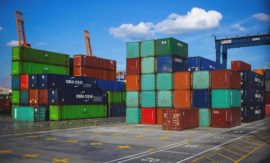Intended learning outcomes: Describe the bill of resources. Explain a way to establish a product load profile from a rough-cut process plan.
Continuation from previous subsection (1.2.5).
A bill of resources is a listing of the required key resources (components and capacities) needed to manufacture one unit of a selected product or product family.
A product load profile is a bill of resources where the resource requirements are defined by a lead-time offset.
In general, this is a matter of one-level rough-cut bills of material and/or routing sheets.
Example: Figure 1.2.5.2 shows two variants of a product load profile for the example in Figure 1.2.5.1. Notice the contraction to one structural level. To do this, lead-time offset must be calculated for each operation. The second variant additionally joins together all positions that load the same rough-cut resource within 10 units of time. This further reduces the complexity of the rough-cut business object.
Fig. 1.2.5.2 The product load profile: a one-level rough-cut bill of material and one-level rough-cut routing sheet.
In some cases, rough-cut business objects can be derived from detailed business objects in a direct fashion. Manual, synchronous modification of rough-cut and detailed business objects is difficult and expensive. Therefore, rough-cut business objects are often kept general enough that they will not be affected by changes in the detailed business object.
Course section 1.2: Subsections and their intended learning outcomes

1.2 Business Objects
Intended learning outcomes: Present business-partner, and order-related business objects in detail. Explain product-related, process-related, and resource-related business objects. Produce an overview on rough-cut business objects.

1.2.1 Customer, Supplier: Business-Partner Objects; Order, Customer Order, Procurement Order, Production Order, Overhead Order: Order-Related Business Objects
Intended learning outcomes: Present in detail the order as a business object. Produce an overview on terms such as customer, supplier, business partner, due date, customer order, procurement order, production order, overhead order.

1.2.1b Order Promising, Order Confirmation, Order Status, Order Header, Order Main Section, Order Footer: Order-Related Business Objects
Intended learning outcomes: Produce an overview on terms such as order promising, order confirmation, order status. Differentiate between order positions for items (to be) delivered and labor (to be) performed.

1.2.2 Item, Component, End Product, Assembly, Raw Material, Spare Part, Item Family: Product-Related Objects
Intended learning outcomes: Produce an overview on business objects such as item, specializations thereof (particularly part and component), spare part and item family.

1.2.2b Product Structure, Bill of Material, Product Family, Product Variant, Commonality: Product-Related Objects
Intended learning outcomes: Explain the product structure and the bill of material. Differentiate between a convergent and a divergent product structure. Describe the concepts of product family, product variant, and commonality.

1.2.3 Operation, Operation Time, Setup, Run Time, Routing Sheet, Critical Path, Interoperation Time, Production Lead Time: Process-Related Business Objects
Intended learning outcomes: Present in detail business objects such as operation, setup and run time. Explain the routing sheet, the critical path, interoperation time and the production lead time.

1.2.3b Production Structure, Product Module, Cumulative Lead Time, Process Plan, Lead-Time Offset: Process-Related Business Objects
Intended learning outcomes: Describe the production structure, the product module, and the cumulative lead time. Disclose the process plan. and the lead-time offset.

1.2.4 Employees, Facilities, Workstation, Production Equipment, Work Center, Capacity, Load, Standard Load, Actual Load: Resource-Related Business Objects
Intended learning outcomes: Produce an overview on terms such as employees, facilities, workstations, production equipment, work center, capacity, load, work-center load. Differentiate between standard load and actual load

1.2.4b Work Center Load, Load Profile, Capacity Utilization, Work Center Efficiency, Rated Capacity: Resource-Related Business Objects
Explain the work-center load and the load profile of a work center. Disclose capacity utilization and work center efficiency. Differentiate between rated capacity and theoretical capacity.

1.2.5 Rough-Cut Product Structure, Rough-Cut Work Center, Rough-Cut Operation, Rough-Cut Process Plan: Rough-Cut Business Objects
Intended learning outcomes: Identify reasons and principles for defining rough-cut business objects. Disclose the rough-cut product structure, the rough-cut work center, the rough-cut operation, and the rough-cut process plan. Explain a way to derive a rough-cut process plan from a detailed process plan.

1.2.5b Bill of Resources, Product Load Profile: Rough-Cut Business Objects
Intended learning outcomes: Describe the bill of resources. Explain a way to establish a product load profile from a rough-cut process plan.
